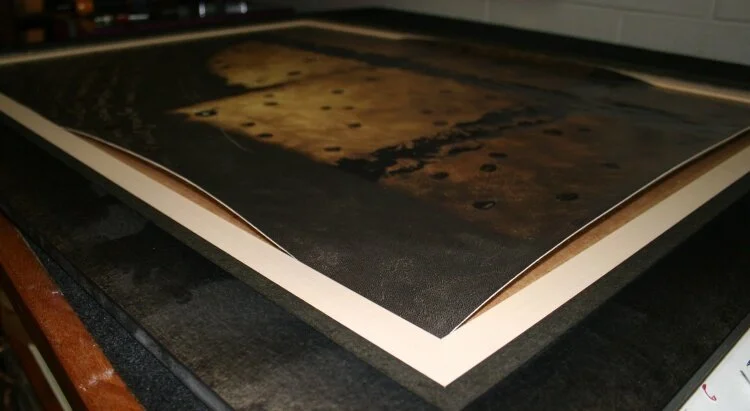All too often we see the damage done to clients’ work through dodgy and lazy workmanship. Recently I had a lovely client come in with a quite recent limited edition print on canvas. A first wedding anniversary present from her husband, she had brought the piece with her from the UK when moving to Australia. The change in environment, particularly Australia’s humidity, had hastily revealed the careless short cuts the previous framer had taken.
Instead of stretching the canvas over a support frame, the framer simply sliced off the excess canvas and glued the canvas to a piece of MDF with a layer of dry mount adhesive - somewhat like a big sticker. As the frame rebate did not cover over the edge of the image, and the adhesive is not designed to permanently adhere fabric (only paper), the canvas began to lift and bubble from the backing board. (Note: MDF can be toxic towards artwork as it contains acids that can damage work that is adhered to it. It should never be used in conservation framing for this reason.)
Needless to say the client was devastated that the previous framer had been so brutal and careless with the piece, which for her is a timeless reminder of her and her husband’s marriage vows and love. These are the pieces that are irreplaceable and why all framers should ask “Why are you bringing this to frame?”, “What does it mean to you?”, “Do you want this to last a long time?”. Despite the damage to the artwork, we were able to re-frame the artwork in a way that will help prevent future issues.
We fully removed the canvas from the MDF support and mounted it to a new larger piece of raw cotton canvas using a strong, acid free wet mount glue and pressing technique to ensure the work was completely flat. By doing this we were able to essentially recreate the canvas that had been cut off. Now it was ready to be stretched correctly as any work on canvas should be. This technique can be used for any painting that does not have enough “bleed” or border for stretching. (Note: this technique requires experience and understanding of different mediums and substrates to ensure that the work isn’t damaged in the process.)
As the original cream slip frame did not cover over the edge of the painting, we chose a similar but slightly wider frame for the inner so that the original outer frame did not have to be replaced or cut down. It is always risky breaking down a frame to make it smaller and the client liked the original framing.
We are now confident that this piece is better equipped to withstand our humid Queensland climate, but more importantly our client has her precious memory restored and hanging in her home.
Do you need us to fix a frame?
We'd love help you with your framing project - if you'd love to have us make this happen, Contact Us and submit the form for a quick quote.
Have you found this information useful? Tell your friends on Facebook and while you're there, don't forget to Like our page so you can keep up to date on cool interior design and art stuff!





